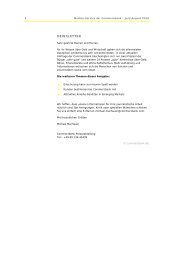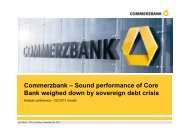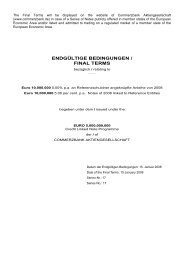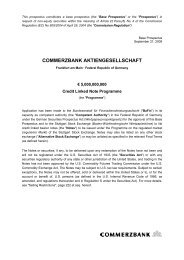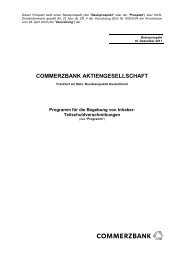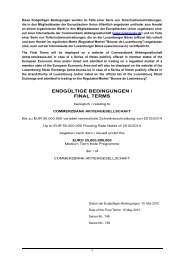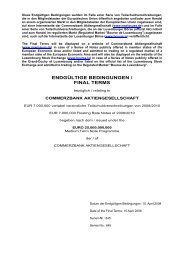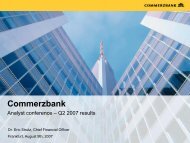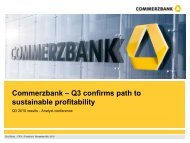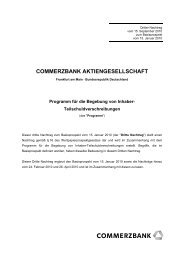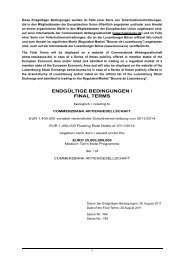COMMERZBANK AKTIENGESELLSCHAFT
COMMERZBANK AKTIENGESELLSCHAFT
COMMERZBANK AKTIENGESELLSCHAFT
You also want an ePaper? Increase the reach of your titles
YUMPU automatically turns print PDFs into web optimized ePapers that Google loves.
To our Shareholders Corporate Responsibility Management Report Risk Report Group Financial Statements Further Information 221 277<br />
258 202 Statement of comprehensive income<br />
260 204 Balance sheet<br />
262 206 Statement of changes in equity<br />
264 208 Cash flow statement<br />
266 210 Notes<br />
409 353 Auditors’ report<br />
The application of hedge accounting rules is tied to a number of<br />
conditions. These relate above all to the documentation of the<br />
hedging relationship and also to its effectiveness.<br />
The hedge must be documented at inception. Documentation<br />
must include in particular the identification of the hedging<br />
instrument, the related hedged item or transaction, the nature of<br />
the risk being hedged and how effectiveness of the hedge is<br />
assessed. In addition to documentation, IAS 39 requires the<br />
effectiveness of a hedge to be demonstrated during the entire<br />
term of the hedge in order for hedge accounting rules to be<br />
applied. Effectiveness in this context means the relationship<br />
between the change in fair value or cash flow of the hedged item<br />
and the change in fair value or cash flow of the hedging<br />
instrument. If these changes offset each other almost fully, a<br />
high degree of effectiveness exists. Proof of effectiveness<br />
requires, firstly, that a high degree of effectiveness can be<br />
expected from a hedge in the future (prospective effectiveness);<br />
secondly, when a hedge exists, it must be regularly<br />
demonstrated that it was highly effective during the period<br />
under review (retrospective effectiveness). Both the<br />
retrospective and prospective effectiveness must be within a<br />
range of between 0.8 and 1.25.<br />
Commerzbank uses regression analysis to assess<br />
effectiveness in micro fair value hedge accounting. The changes<br />
in fair value of the hedged transaction and the hedging<br />
instrument are determined by means of historical simulations for<br />
the prospective effectiveness test, while the actual changes in<br />
fair value are used for the retrospective effectiveness test.<br />
Regression analysis is also used for the prospective effectiveness<br />
test in portfolio fair value hedge accounting, while the dollaroffset<br />
method is used for the retrospective effectiveness test.<br />
(6) Currency translation<br />
Monetary assets and liabilities denominated in foreign<br />
currencies and pending spot foreign exchange transactions are<br />
translated at the spot mid rate, and foreign exchange forward<br />
contracts at the forward rate, on the balance sheet date. Realised<br />
income and expenses are normally translated using the spot rate<br />
applying on the date of realisation. Average prices may also be<br />
used to translate income and expenses, provided these prices<br />
are representative, i.e. the price has not undergone major<br />
fluctuations. Hedged expenses and income are translated using<br />
the hedge rate. Expenses and income resulting from the<br />
translation of balance sheet items are recognised in profit or loss<br />
under net trading income.<br />
Non-monetary items such as equity holdings are generally<br />
translated at historic exchange rates, if they are measured at<br />
amortised cost. The hedging instruments are measured at fair<br />
value. Gains and losses on the translation of non-monetary items<br />
are recognised either in equity or profit or loss depending on the<br />
way the net gain or loss is recognised.<br />
Income and expenses in the financial statements of<br />
consolidated subsidiaries and companies accounted for using<br />
the equity method are translated at the exchange rate prevailing<br />
on the transaction date. For simplification purposes a price can<br />
be used for translation which represents an approximation of the<br />
exchange rate on the transaction date, for example the average<br />
price of a period. All differences arising on translation are<br />
recognised as a separate component of equity in the currency<br />
translation reserve. Translation gains and losses from the<br />
consolidation of the capital accounts are also recognised in<br />
equity under the currency translation reserve. On the date such<br />
assets are sold, the translation gains or losses are recognised in<br />
profit or loss under net investment income.<br />
Group Financial Statements



